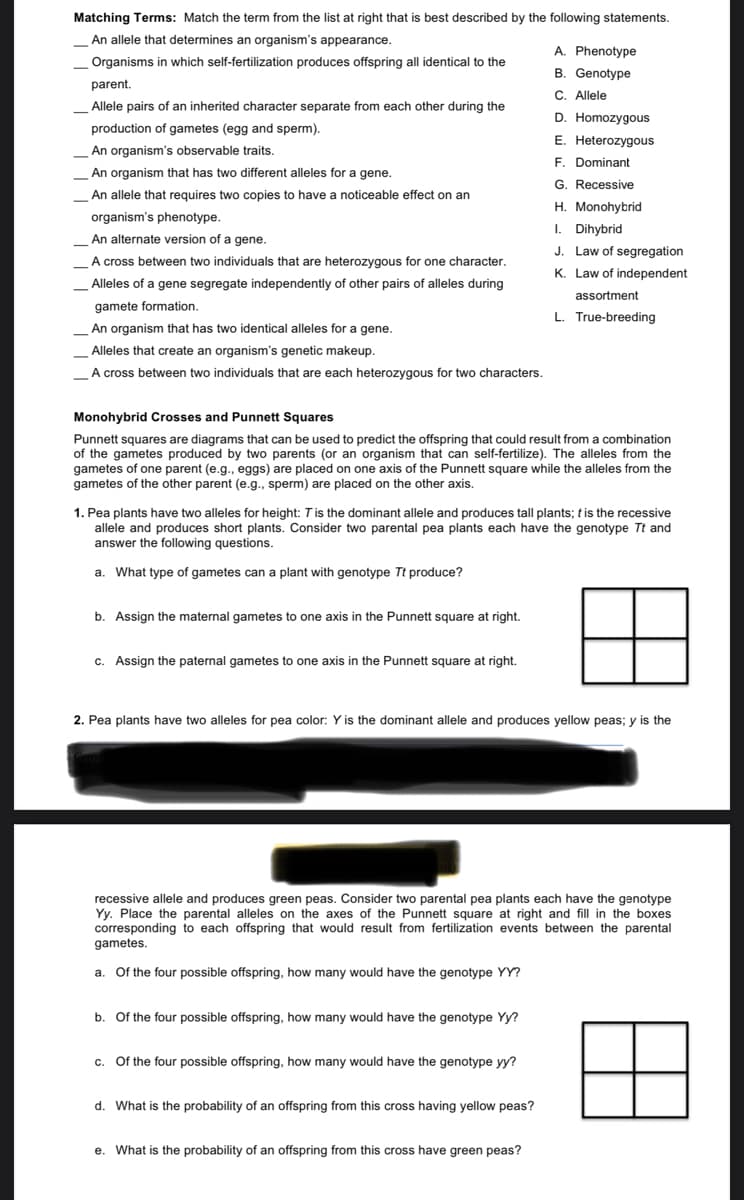Matching Terms: Match the term from the list at right that is best described by the following statements. An allele that determines an organism's appearance. A. Phenotype Organisms in which self-fertilization produces offspring all identical to the B. Genotype C. Allele parent. _ Allele pairs of an inherited character separate from each other during the D. Homozygous production of gametes (egg and sperm). E. Heterozygous F. Dominant G. Recessive An organism's observable traits. An organism that has two different alleles for a gene. An allele that requires two copies to have a noticeable effect on an H. Monohybrid organism's phenotype. 1. Dihybrid J. Law of segregation _An alternate version of a gene. A cross between two individuals that are heterozygous for one character. K. Law of independent Alleles of a gene segregate independently of other pairs of alleles during assortment gamete formation. L. True-breeding An organism that has two identical alleles for a gene. Alleles that create an organism's genetic makeup. A cross between two individuals that are each heterozygous for two characters.
Matching Terms: Match the term from the list at right that is best described by the following statements. An allele that determines an organism's appearance. A. Phenotype Organisms in which self-fertilization produces offspring all identical to the B. Genotype C. Allele parent. _ Allele pairs of an inherited character separate from each other during the D. Homozygous production of gametes (egg and sperm). E. Heterozygous F. Dominant G. Recessive An organism's observable traits. An organism that has two different alleles for a gene. An allele that requires two copies to have a noticeable effect on an H. Monohybrid organism's phenotype. 1. Dihybrid J. Law of segregation _An alternate version of a gene. A cross between two individuals that are heterozygous for one character. K. Law of independent Alleles of a gene segregate independently of other pairs of alleles during assortment gamete formation. L. True-breeding An organism that has two identical alleles for a gene. Alleles that create an organism's genetic makeup. A cross between two individuals that are each heterozygous for two characters.
Human Heredity: Principles and Issues (MindTap Course List)
11th Edition
ISBN:9781305251052
Author:Michael Cummings
Publisher:Michael Cummings
Chapter7: Development And Sex Determination
Section: Chapter Questions
Problem 9QP
Related questions
Topic Video
Question

Transcribed Image Text:Matching Terms: Match the term from the list at right that is best described by the following statements.
An allele that determines an organism's appearance.
A. Phenotype
Organisms in which self-fertilization produces offspring all identical to the
B. Genotype
parent.
C. Allele
Allele pairs of an inherited character separate from each other during the
D. Homozygous
production of gametes (egg and sperm).
E. Heterozygous
An organism's observable traits.
F. Dominant
An organism that has two different alleles for a gene.
G. Recessive
An allele that requires two copies to have a noticeable effect on an
H. Monohybrid
organism's phenotype.
I. Dihybrid
An alternate version of a gene.
J. Law of segregation
A cross between two individuals that are heterozygous for one character.
K. Law of independent
Alleles of a gene segregate independently of other pairs of alleles during
assortment
gamete formation.
L. True-breeding
An organism that has two identical alleles for a gene.
Alleles that create an organism's genetic makeup.
A cross between two individuals that are each heterozygous for two characters.
Monohybrid Crosses and Punnett Squares
Punnett squares are diagrams that can be used to predict the offspring that could result from a combination
of the gametes produced by two parents (or an organism that can self-fertilize). The alleles from the
gametes of one parent (e.g., eggs) are placed on one axis of the Punnett square while the alleles from the
gametes of the other parent (e.g., sperm) are placed on the other axis.
1. Pea plants have two alleles for height: Tis the dominant allele and produces tall plants; tis the recessive
allele and produces short plants. Consider two parental pea plants each have the genotype Tt and
answer the following questions.
a.
What type of gametes can a plant with genotype Tt produce?
b. Assign the maternal gametes to one axis in the Punnett square at right.
c. Assign the paternal gametes to one axis in the Punnett square at right.
2. Pea plants have two alleles for pea color: Y is the dominant allele and produces yellow peas; y is the
recessive allele and produces green peas. Consider two parental pea plants each have the genotype
Yy. Place the parental alleles on the axes of the Punnett square at right and fill in the boxes
corresponding to each offspring that would result from fertilization events between the parental
gametes.
a.
Of the four possible offspring, how many would have the genotype YY?
b. Of the four possible offspring, how many would have the genotype Yy?
C.
Of the four possible offspring, how many would have the genotype yy?
d. What is the probability of an offspring from this cross having yellow peas?
e. What is the probability of an offspring from this cross have green peas?
Expert Solution
This question has been solved!
Explore an expertly crafted, step-by-step solution for a thorough understanding of key concepts.
This is a popular solution!
Trending now
This is a popular solution!
Step by step
Solved in 2 steps

Knowledge Booster
Learn more about
Need a deep-dive on the concept behind this application? Look no further. Learn more about this topic, biology and related others by exploring similar questions and additional content below.Recommended textbooks for you

Human Heredity: Principles and Issues (MindTap Co…
Biology
ISBN:
9781305251052
Author:
Michael Cummings
Publisher:
Cengage Learning

Human Heredity: Principles and Issues (MindTap Co…
Biology
ISBN:
9781305251052
Author:
Michael Cummings
Publisher:
Cengage Learning